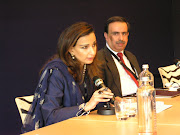Next week, health permitting, Prime Minister Atal Behari Vajpayee will undertake probably the most significant foreign 'yatra' of his political career.
This nearly fortnight-long trip to the United States could be a milestone in the history of bilateral relations, and yet it is a visit that that some have dubbed as unnecessary and irrelevant. Others have suggested that this new engagement with the U.S. goes against the principles that have traditionally guided India's foreign policy. All this is pure baloney, articulated by those who belong to the dustbin of history, or those apparatchiks who still yearn for the old days of Stalinist communism.
Let us face some hard facts. There is arguably no other relationship that is as critical to India today as the one with the U.S., and dubbing anyone who says this to be a CIA agent will not change the truth. The U.S. is the only real superpower in the international system, and its hegemony is unlikely to be challenged - even by a determined China - for the next 25 years.
Since the end of World War II, the U.S. has been a key player in the international relations of Asia and will continue to exercise a vital influence on the region in the future as well. Additionally, the U.S. remains India's largest trading partner, and is the single most attractive destination for skilled human capital from India.
Admittedly, while India and the U.S., the largest democracies in the world, have often been viewed natural allies, it is estrangement rather than engagement that seems to have defined relations between New Delhi and Washington through much of the last half century. Also, the Pokhran II nuclear tests by India in May 1998 reduced Indo-U.S. relations to a new low point.
Is this beginning to change? Strident anti-Americanism remains a feature of Indian public opinion and the U.S. still seems unwilling, it seems, to recognize those Indian security concerns, particularly over China and the nuclear nexus between Beijing and Islamabad, that find expression in its nuclear policy. But there are signs of change.
India and the U.S. have sustained a high-level strategic dialogue for nearly two years. During the Kargil war of 1999, the U.S. displayed an unprecedented sensitivity to India's security concerns. New Delhi and Washington, both key targets of Islamic terrorism, have formed a joint working group on the issue. More computer professionals from India were given H1B work permits in the U.S. last year than citizens of any other country, and Indians played a vital role in making U.S. industry Y2K compliant.
The extremely successful Indian expatriate community in the U.S. is playing an important role in bringing the two nations together. Both countries have a stake in the role that China plays in the Asia-Pacific region in the future and in ensuring the stability of Pakistan. Washington seems to increasingly be accepting India as a nuclear-weapons power. President Clinton's trip to India, earlier this year, was an enormous success.
In short, both the present and the potential future make the relationship with the U.S. vital for Indian interests. True, Vajpayee will be meeting President Clinton when he is virtually legless. In about two months a new president would have been elected, and in about four there will be a new occupant in the White House. But the Vajpayee visit must not be narrowly viewed in terms of engaging the current Democratic administration. The trip should be (and presumably is) about engaging America and cementing the gains made over the last two years.
The Vajpayee visit, more specifically, must be viewed in terms of four missions. First, it is about reaching out to American business. U.S. corporations, viewed for years as exploiters and unreliable partners, can become India's most vital allies if the relationship of mutual dependence that exists can find firmer roots.
The example of China should be of extraordinary significance. Perhaps the only real reason for American reluctance to take a harder stand toward Chinese irresponsibility on a score of issues, including their dubious record on nonproliferation, has been the relationship of enormous economic interdependence. It is relationship that a forward-thinking India could prudently emulate.
Second, the Vajpayee visit should also be about reaching out to Indian Americans. Indians in the U.S. are arguably the country's most valuable assets in America. They are on the verge of becoming a powerful economic force, and - with some direction - could emerge as a powerful lobby for Indian interests. While it is difficult to imagine Indian Americans having the same influence as, say, the Jewish lobby, there is enormous scope for them to play a role, and perhaps even a decisive one at that, in shaping U.S. policy toward India.
Third, the Vajpayee visit should also be about reaching out to the policy community, including, but not only, the lawmakers in Congress. Vajpayee is addressing a joint session of the U.S. Congress, and his speech must reflect the vitality and the openness of the "new" India, and its willingness to share American responsibility in the management of the international system. India is ready to be a partner in the quest for global stability, particularly in the Asia-Pacific region, which promises to witness turbulence in the years to come, and Vajpayee must stress this without mincing words.
Finally, Vajpayee must also engage the two most important presidential candidates, Al Gore and George W. Bush, and their aides. Meetings are scheduled with both Gore and Bush, and these occasions must be used to establish a personal bond, and put India on the road map for a future American president.
(Source: indiainfo.com)








